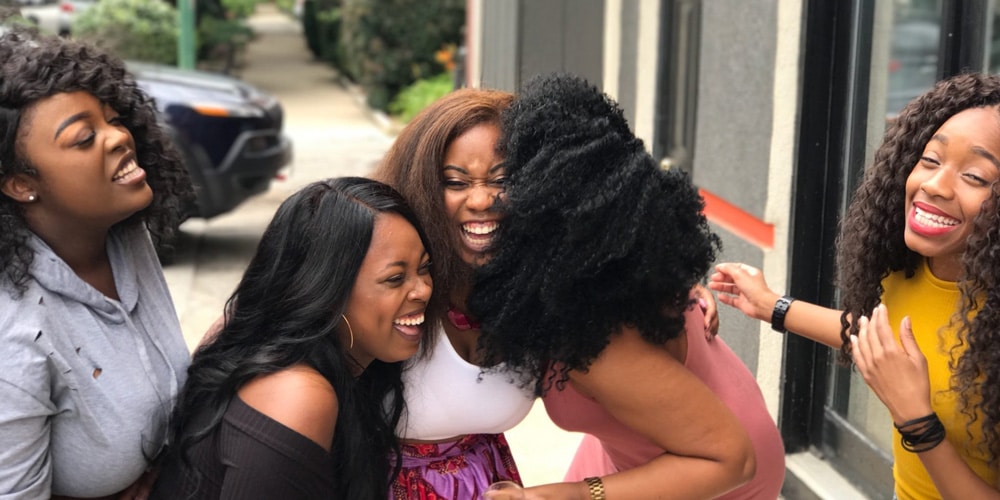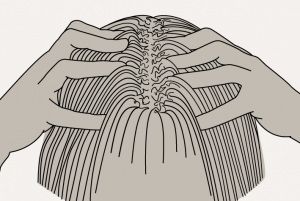Precautions before going to bed and getting up
Before going to bed, lightly massage your scalp then make one or more very loose plaits or braids and lie down, or sleep with a scarf, preferably silk.Avoid cotton, which can make your hair brittle hair and cause a hair loss by breaking, absorbing the moisture they so desperately need. Also avoid synthetics or wool, which can cause the skin to break. sweaty scalp and make hair electric.
Does your hair still feel tangled in the morning? Are you in a hurry? Above all, don't try to untangle them in your haste, you risk breaking more than one! Style your hair superficially without letting the teeth of the comb penetrate your hair.
For deep detangling
It's a long process, sometimes taking 20 to 30 minutes... Proceed section by section holding a portion in one hand and the comb in the other. Always detangle from the bottom up, using a wide-tooth comb. Start at a height of 5 cm from the tip, then gently work your way up towards the scalp.Watch out for the junction between curly and straightened hair! It needs to be treated even more gently to avoid breaking it.
To make detangling easier, you can dampen your hair beforehand. Preferably use a spray bottle and spring water, to which you should add a little virgin oil and light conditioner (to make mixing easier). Proportions: 80% water, 10% oil, 10% cream. The amount of oil can be reduced or increased, depending on how your hair reacts.
Massage to irrigate your roots
Place the pulp of the fingers slightly apart directly onto the skin of the scalp, under your hair. Press firmly, then make a back and forth movement or rotation. Then move the fingers and repeat elsewhere.
Please note, massaging does not mean rubbing The fingers should not slip, but remain firmly anchored on the part of the scalp where you placed them. The principle is to slide the skin along the skull and not the fingers along the skin. Approximately one minute to cover the whole head.
Saving your keratin
The very principle of straightening damages not only the outer surface of your hair (cuticle) but also the keratin fibres inside. Relaxed hair therefore always has a tendency towards "programmed denaturation", to break. That's why remedial action isn't easy... You have to :
- Reconstruct hair by providing sulphur proteins (the very building blocks of keratin), chitin and plant proteins.
- Consolidate repair with a complex of highly penetrating plant oils to nourish the hair deep down.
These two actions are essential: if your hair is rebuilt without being nourished, it will risk of breaking like glass at the slightest pull. If it is just oiled, without the simultaneous addition of proteins, it will become artificially greasy and remain dull and porous. A Clauderer Treatment combines both actions. Within the first month, you'll notice less hair breakage and more shine: two outward signs that, from the inside, your hair is getting healthier. keratin is indeed being reconstituted.
Shampoo, beware of disaster!
Relaxed hair doesn't really like shampooing because that's when it's most likely to break.
Choice of shampoo
It's an important choice, because when you wash your hair, you're doing the following not to destroy the thin film of sebum supposed to protect it. Our advice: don't be fooled by claims about plants that are supposed to be good for your hair. These plants are only of value in a shampoo when they are sufficiently concentrated and when the cleansing base is not too aggressive.
At the Centre Clauderer, we often replace the classic shampoo with a cleansing and revitalising cream (Clauderer Cream N°26R for example). Although it contains no detergents and foams very little, this cream leaves hair clean. Foam is often a sign of aggressiveness rather than cleanliness!
Finally, please note that baby shampoos are not particularly recommended, as this does not mean that they are milder, but that they do not sting the eyes. And for those who prefer homemade products, here are a few simple recipes to concoct for make your own shampoo.
Washing
- Wet your hair gradually with warm water, at around 30, 35°C, then spread a small amount of shampoo over the scalp and lengths.
- Don't rub your head vigorously after applying your shampoo. No matter how gentle the cleansing base, it's still too harsh for fragile roots, and massage won't do anything to keep your hair clean. With your fingers flat, lightly rub your scalp and gently massage your hair from the crown to the ends to avoid tangling. This should take between 1 and 3 minutes, depending on how much hair you have.
- Important: Pour a little at a time the equivalent of one or two bowls of barely warm water on your hair, while continuing to gently massage it. This is to ensure that the shampoo is removed very gradually. Then rinse thoroughly. If your hair doesn't feel clean enough, you can repeat the operation once more. Otherwise, there's no point. For detangling, see above.
- For the last rinse, add a teaspoon of apple vinegar to half a litre of spring water to eliminate limescale, which is particularly harmful to frizzy hair.
Alternating braids and wigs
Between straightenings, if you wear braids or add-ons, make sure that they do not pull too hard on your roots. If the hair is pulled too hard, there is a risk that it will come loose and cause premature hair loss. This loss then artificially triggers a new life cycle for the hair that follows on from the previous one. Eventually, the regrowth will become finer and finer and their lifespan becomes shorter and shorter. Eventually, the hair won't grow back at all in the high-traction areas because you've exhausted its ability to renew itself.
On areas where your hair does not grow back well, lay your hair in braids along your scalp and not too tight on the first two cm. As for additions, do not from where your hair grows back correctly.
If you're wearing a wig, we recommend that you sew a small border around it (no more than 1cm high), so that the edges won't irritate your scalp and damage your new hair. When you take off your wig, massage your scalp to increase blood flow to your roots (as described above).
Frequency of your straightening
If you want to protect your hair try to space out your straightening more and more. With a Clauderer treatment, this will become possible as the difference in quality between relaxed hair and new growth will very quickly become less of a problem. Have your straightening done by a good hairdresser, making sure that the product is not used on the hair. applied only to regrowth. If possible, opt for the softening technique, which is less aggressive than traditional straightening: it retains moisture better. And if one day you decide to go back to your natural hair, don't delay - read our dossier the return of natural frizzy hair.



Good afternoon, Madam. Thank you for your message. If you choose to straighten your hair, appropriate care is essential. We will be able to advise you on the hair routine to adopt as soon as we receive your request for a diagnosis. Please do not hesitate to contact us for an appointment on site or an analysis by correspondence. The Clauderer Team